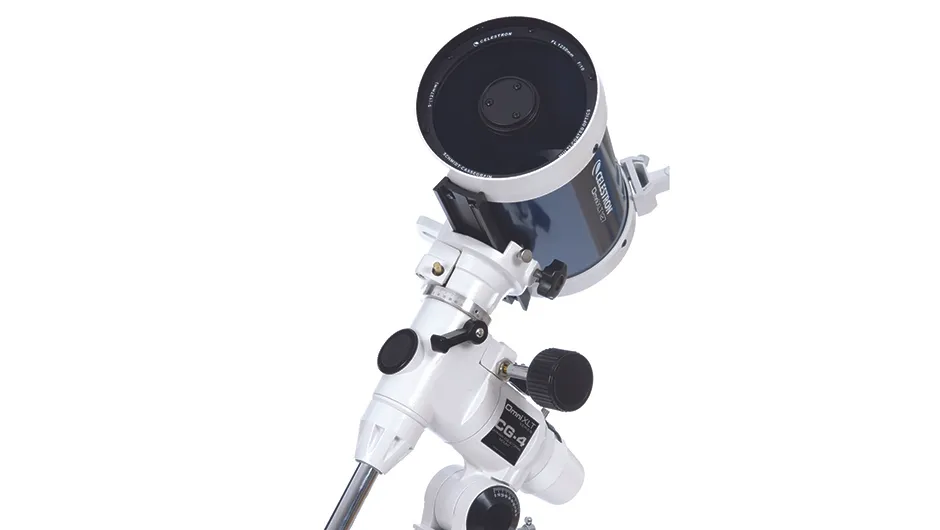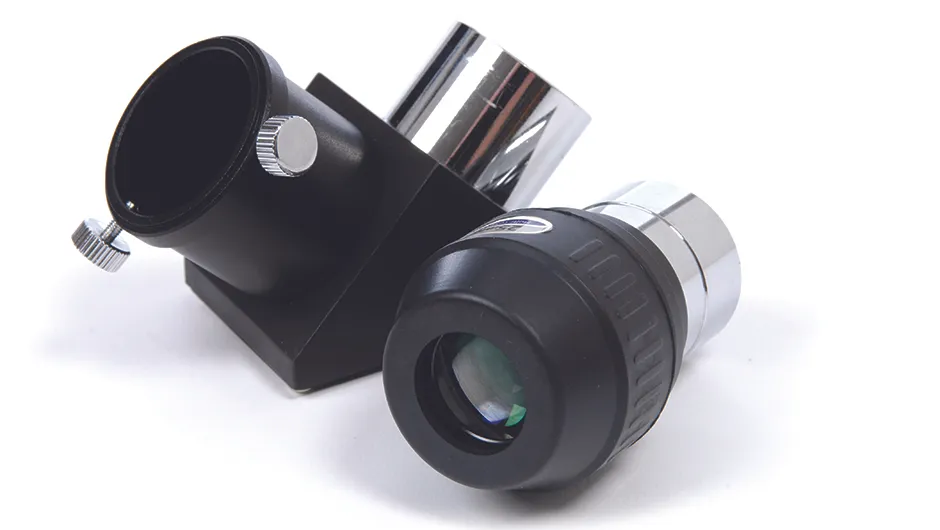Celestron has recently introduced a new range of affordable yet high-quality scopes.Among this new batch is the promising 5-inch (127mm) Schmidt-Cassegrain telescope (SCT), which comes with an Omni CG4 equatorial mount.
It certainly looks smart in white and blue, and it’s surprisingly lightweight – allowing you to move it around with ease.
The mount and tube are relatively quick to set up, so we had more time to take advantage of those rare clear spells that came our way during a wet spell of weather, when we were testing it.
As well as being easy to handle, the CG4 mount is sturdy.
Its tubular legs give perfect support for the equatorial mount, which is well made and robust. Indeed, the setup is rigid enough to provide a good, solid base for astro imaging.
The mount also comes with two counterweights, but we found that in practice the telescope actually only required one.
The second counterweight would be useful if you wanted to attach heavier telescope tubes, however.

One thing that stands out with this telescope is how compact and light it is.
It’s too easy to be talked into buying a larger scope than you need, and dragging the weighty components out on a clear night can quickly become a chore.
If a scope is light and easily portable then there is far more chance that you’ll use it regularly, and the Omni XLT 127 scores highly on this level.
The tube assembly is very short at only 28cm (11 inches), and very light so that almost anyone would be able to carry it.
This is thanks to its Schmidt-Cassegrain design, which produces a very compact optical system housed in a light but well-constructed tube.
The CG4 mount/tripod is also relatively portable thanks to the lightweight yet strong components; it weighs in at 15kg (33lb) including both of the counterweights.
Yet the mount still retains plenty of rigidity and, coupled to the hollow stainless steel tubing used for the legs, makes for a sturdy yet portable platform.
The slow-motion control on the mount’s declination axis did seem a little stiff, but this could easily be remedied and would almost certainly improve with frequent use over time.
The telescope tube attaches to the CG4 mount with a Vixen-style mounting bar.However, this mounting bar is screwed directly to the tube and not to tube rings.
Consequently, the tube cannot be rotated within the rings once it is fixed in position on the mount.
This means that the finderscope is also in a fixed position on the scope’s tube, and sometimes ended up in an awkward position.
It’s not too much of a problem on a compact scope like this; for the majority of our observations the small 6x30 finderscope was usable and gave clear views.
Other accessories included with the Omni 127 are a star diagonal and one eyepiece.With a focal length of 25mm, the eyepiece gives a magnification of 50x and a field of view of about one degree.
In fairness, the addition of the star diagonal does go some way towards compensating for the fixed position of the tube: once you’ve located your target in the sky you can rotate the star diagonal into the right position so that the eyepiece is comfortably placed for observing.
To test the optics we viewed Arcturus and Vega as they drifted across the field of view.
The optics were clear and sharp across at least the central 65 per cent, and there was only a slight trailing off towards the edges.
The overall view using the supplied 25mm eyepiece was certainly enjoyable.
Star colours were well defined: the double star Albireo showed some nice sky blue and gold components, with a good, crisp separation of the wide pair.

Doubling up
To see how well the scope could do under higher magnifications we also used our own 6.5mm eyepiece to view epsilon (ε) Lyra, the quadruple star also known as the Double Double.
We were pleased to see both pairs of doubles were split, with clear dark sky between each pair of stars: proof that this telescope bears higher magnifications well.
Turning towards the first quarter Moon and nearby Jupiter, we saw crisp lunar craters, and we could easily pick out the belts and moons of the gas giant.
Next on our list were deep-sky objects, and these were clearly viewed.
The globular clusters M13 and M92 looked like large and small balls of cotton wool.
Tantalisingly, we could have sworn that we even caught a glimpse of the faint mag. 12.1 galaxy NGC 6207 near to M13 using our 6.5mm eyepiece!
Meanwhile, open star clusters such as M11 and the Double Cluster sparkled with lots of stars and were a joy to behold.
Turning to nebulae, we chose the Dumbbell Nebula (Messier 27) and, lower in the sky, the Swan Nebula (Messier 17).
Both showed good contrast, standing out well against the background sky and displaying subtle hints of detail that was rewarding to see.
We did notice during these observations that the front lens had a tendency to dew up fairly easily, but this can be quickly remedied by placing a simple cardboard tube over the front.
Overall then, the Omni worked very well and we recommend it because it’s an excellent all-round performer. It’s definitely a purchase worth considering.

Vital stats
- Price: £519.00
- Aperture: 5 inches (127mm)
- Focal Length: 1,250mm (f/9.84)
- Eyepieces: 25mm
- Finderscope: 6x30
- Weight: 18kg
- Supplier: David Hinds Ltd
- Telephone: 0845 260 4770
- Website:www.celestron.uk.com
This article appeared in the November 2007 issue of Sky at Night Magazine
